 A group of leading and innovative companies have joined together to recommend national legislation to slow, stop and reverse the growth of greenhouse gas emissions. And a national cap-and-trade carbon reduction system using precision technology is at the heart of the program.
A group of leading and innovative companies have joined together to recommend national legislation to slow, stop and reverse the growth of greenhouse gas emissions. And a national cap-and-trade carbon reduction system using precision technology is at the heart of the program.
Robert W. Lane, chairman and chief executive officer of Deere & Company, joined other business leaders in Washington D.C. recently to unveil the U.S. Climate Action Partnership’s “Blueprint for Legislative Action.” The blueprint is a comprehensive and detailed set of integrated policy recommendations for developing legislation that would create an environmentally effective and economically sustainable national climate protection program.
“We are pleased that USCAP has reached consensus on a comprehensive Blueprint for Legislative Action which reinforces our commitment to slow, stop and reverse the growth of greenhouse gas (GHG) emissions. In order to effectively address climate change internationally, the U.S. must play a leading role. Significant cost savings to the overall cap- and-trade system can be realized by utilizing robust levels of offsets, both domestically and internationally, as this Blueprint reflects.
“The agriculture, forestry, and land use sectors have the potential to reduce and sequester a significant portion of the nation’s total greenhouse gas emissions, as well as generate renewable energy and produce low-carbon fuels. A robust emissions offset program established from the outset of cap-and-trade will create opportunities to reduce emissions or increase sequestration practices that can generate revenue for rural communities, provide multiple environmental and social benefits, improve air quality, and ensure cost-efficient emissions reductions.”
This effort includes 26 companies and five environment groups as members. Business leaders from these committed companies participated in Congressional briefings and a public press conference to announce the blueprint.
For more information, visit www.us-cap.org.
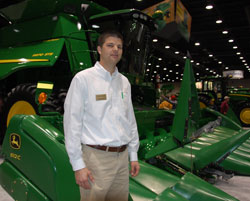 A new sensing system on corn heads called AutoTrac™ RowSense™ allows precision guidance to be used on combines that are harvesting corn.
A new sensing system on corn heads called AutoTrac™ RowSense™ allows precision guidance to be used on combines that are harvesting corn.
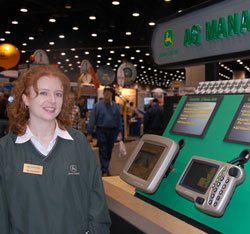 “On one hand we have new products for operators who have yet to get into precision ag,” says Kim Fletcher with
“On one hand we have new products for operators who have yet to get into precision ag,” says Kim Fletcher with 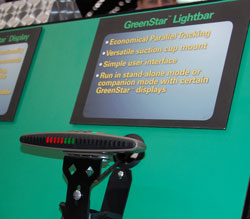 For more advanced system users, Kim says they have new products for them as well. “We came out with a GS2 Rate Controller Multi-Product, which can control multiple products or multiple operations at once.”
For more advanced system users, Kim says they have new products for them as well. “We came out with a GS2 Rate Controller Multi-Product, which can control multiple products or multiple operations at once.”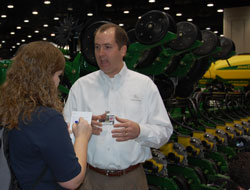 Rob Rippchen, division marketing manager at John Deere seed in Moline, IL says the DB120 “next generation” 120 foot planter is generating a lot of interest at the show. “There’s kind of a ‘wow’ factor,” said Rob. “It’s so wide it can’t even unfold all the way in our booth.” But he says the outer four row units fold over on each end so it is still the same transport width as the DB90 and just about six foot longer in transport length.
Rob Rippchen, division marketing manager at John Deere seed in Moline, IL says the DB120 “next generation” 120 foot planter is generating a lot of interest at the show. “There’s kind of a ‘wow’ factor,” said Rob. “It’s so wide it can’t even unfold all the way in our booth.” But he says the outer four row units fold over on each end so it is still the same transport width as the DB90 and just about six foot longer in transport length. The popular
The popular  With tighter margins and higher input costs, now is the time to implement the
With tighter margins and higher input costs, now is the time to implement the 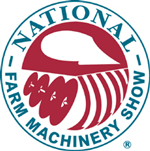 More than 150,000 Kentucky residents were still without power this week after ice storms the last week of January, prompting President Obama to declare more than 90 counties a major disaster area and order federal aid to supplement local recovery efforts.
More than 150,000 Kentucky residents were still without power this week after ice storms the last week of January, prompting President Obama to declare more than 90 counties a major disaster area and order federal aid to supplement local recovery efforts. USDA’s Natural Resources Conservation Service in Alabama has announced a new Precision Farming Incentive for farmers in that state.
USDA’s Natural Resources Conservation Service in Alabama has announced a new Precision Farming Incentive for farmers in that state. Spraying orchards is a messy but necessary job. And if
Spraying orchards is a messy but necessary job. And if  A group of leading and innovative companies have joined together to recommend national legislation to slow, stop and reverse the growth of greenhouse gas emissions. And a national cap-and-trade carbon reduction system using precision technology is at the heart of the program.
A group of leading and innovative companies have joined together to recommend national legislation to slow, stop and reverse the growth of greenhouse gas emissions. And a national cap-and-trade carbon reduction system using precision technology is at the heart of the program.